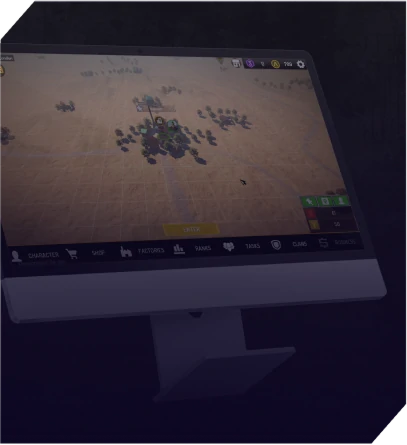AR game development services we offer

Web3
As technologies of Web3 and AR continue to develop, we can expect to see more innovative and creative applications that bridge the gap between the physical and digital worlds.

Unreal Engine
Unreal Engine is a powerful tool for creating 3D content, making it perfect for delivering augmented game development services. With advanced features like object recognition and camera tracking, it enables developers to seamlessly blend digital and physical worlds in real time. Its proven expertise in virtual reality (VR) content further solidifies Unreal Engine as a top choice for augmented reality (AR) development.

Unity
Unity is a popular engine for creating Augmented Reality (AR) experiences. It offers tools for 3D graphics, animations, and physics simulations and supports AR features like object recognition and camera tracking. With a large developer community and VR capabilities, it's a versatile choice for creating engaging AR content.

AR kits
AR software development kits (SDKs) provide developers with pre-built tools and libraries for creating AR experiences without starting from scratch. Popular kits include ARCore for Android, ARKit for iOS, and third-party options like Wikitude. Documentation is provided, allowing for rapid development and modifications. Choosing the fitting kit is essential for the platform and project requirements.

AR Game Development
As AR game developers , we provide immersive and interactive experiences as per your vision. We provide tailor-made AR game development services that enthrall your audience with the latest augmented reality outsourcing solutions .

AR Game Art
Get high visual quality with the help of our professional AR game developers who will take your AR gaming projects to the next level. Augmented reality outsourcing services for AR game art that is attuned to your creative and technical needs.

AR Game Design
Turn your ideas into an exciting gaming experience! As expert AR developers, we focus on creating unique mechanisms, designing seamless interfaces for players to be a part of changing and animated AR zones.

Prototyping
Save time on AR game development with rapid prototyping services. Your trusted AR game development company, we assure you, our augmented reality outsourcing solutions will make your dreams a reality in no time.
Why US
-
01
A trusted augmented reality game development company offering end-to-end solutions for projects of all sizes and complexities.
-
02
As a forward-thinking augmented reality development company , we combine storytelling and innovation to elevate player immersion and experience.
-
03
Our seasoned AR game developers and designers craft engaging, immersive experiences that resonate with players on any platform.
-
04
We specialize in bespoke AR game development services, ensuring every project is uniquely aligned with your goals and target audience.
-
05
As an AR app development company, we deliver dynamic solutions for mobile, web, and other platforms, ensuring your product reaches its full potential.
-
06
As a leader in augmented reality outsourcing, we employ state-of-the-art technologies to create groundbreaking AR experiences.
Our Usual AR Game Development Process
AR Industries
-
 MEDICAL EDUCATION AND TRAININGAR is a vital teaching tool for med students. It creates 3D images of organs that look like real living things, which helps surgeons understand complex procedures quickly and saves them valuable time. Many AR game developers are now creating specialized augmented reality development company tools to enhance learning experiences in the medical field.
MEDICAL EDUCATION AND TRAININGAR is a vital teaching tool for med students. It creates 3D images of organs that look like real living things, which helps surgeons understand complex procedures quickly and saves them valuable time. Many AR game developers are now creating specialized augmented reality development company tools to enhance learning experiences in the medical field. -
 GAMING AND ENTERTAINMENT SECTORPokemon Go's use of augmented reality created unprecedented popularity, with over 250 million monthly players. The game demonstrated the vast potential of AR in entertainment and gaming, particularly in mobile gaming. This success highlights the capabilities of an AR game development company to create engaging AR game development solutions that bring immersive experiences to life.
GAMING AND ENTERTAINMENT SECTORPokemon Go's use of augmented reality created unprecedented popularity, with over 250 million monthly players. The game demonstrated the vast potential of AR in entertainment and gaming, particularly in mobile gaming. This success highlights the capabilities of an AR game development company to create engaging AR game development solutions that bring immersive experiences to life. -
 RETAIL SECTORAugmented reality is an excellent tool for retailers to engage online and in-store customers. It's beneficial for try-on experiences like eyewear, makeup, and furniture.
RETAIL SECTORAugmented reality is an excellent tool for retailers to engage online and in-store customers. It's beneficial for try-on experiences like eyewear, makeup, and furniture. -
 DESIGN, BRANDING, AND MODELLINGAR game design helps us visualize concepts in a physical environment and understand their size, shape, and surroundings. It provides a higher fidelity visualization, allowing us to envision the end product better. AR game designers use these capabilities to create realistic in-game environments that enhance gameplay experiences.
DESIGN, BRANDING, AND MODELLINGAR game design helps us visualize concepts in a physical environment and understand their size, shape, and surroundings. It provides a higher fidelity visualization, allowing us to envision the end product better. AR game designers use these capabilities to create realistic in-game environments that enhance gameplay experiences. -
 TOURISM BUSINESSAR enhances travel by offering personalized experiences based on location. Gatwick Airport has tested AR to guide passengers with navigational beacons and a smartphone app. With the rise of augmented reality outsourcing, more travel companies are partnering with augmented reality game developers to incorporate AR into their services.
TOURISM BUSINESSAR enhances travel by offering personalized experiences based on location. Gatwick Airport has tested AR to guide passengers with navigational beacons and a smartphone app. With the rise of augmented reality outsourcing, more travel companies are partnering with augmented reality game developers to incorporate AR into their services. -
 EDUCATION SECTORAR revolutionizes education by allowing learners to interact with inaccessible objects from their familiar environment. Educators worldwide are incorporating it into their methods; we expect this trend to continue and grow.
EDUCATION SECTORAR revolutionizes education by allowing learners to interact with inaccessible objects from their familiar environment. Educators worldwide are incorporating it into their methods; we expect this trend to continue and grow.
The Value of Whimsy Games




- Time Savers
- Easy Power-Ups
- Smart Spending
- Top Quality
Ready, Set, Go!
No waiting for respawns. We’re fast and always game to start!
Level Up Instantly!
Scale your project like a pro, from pixel beginnings to epic quests.
Win More, Spend Less!
Get legendary results without emptying your loot chest.
Play Flawlessly!
Every project gets our champion-level QA. No bugs allowed!
We strive for excellence













Genres We Сreate
- Adventure Games
- Puzzle Games
- Card Games
- Shooters

Adventure Games
Our metaverse game developers produce captivating adventure games that allow users to immerse themselves in an intriguing virtual environment.
Contact us
Puzzle Games
We make challenging puzzle games that engross the players entirely. To win, they will need to focus their full attention and intelligence.
Contact us
Card Games
Our Metaverse game creation allows players to have a casino-like experience without leaving their homes. Whimsy Games' developers integrate the aspects that make the game distinctive.
Contact us
Shooters
Our team comprises developers and designers who create games with smooth functioning and dynamism. Our professionals devote close attention to detail while crafting distinctive characters.
Contact us




























What our clients think about us